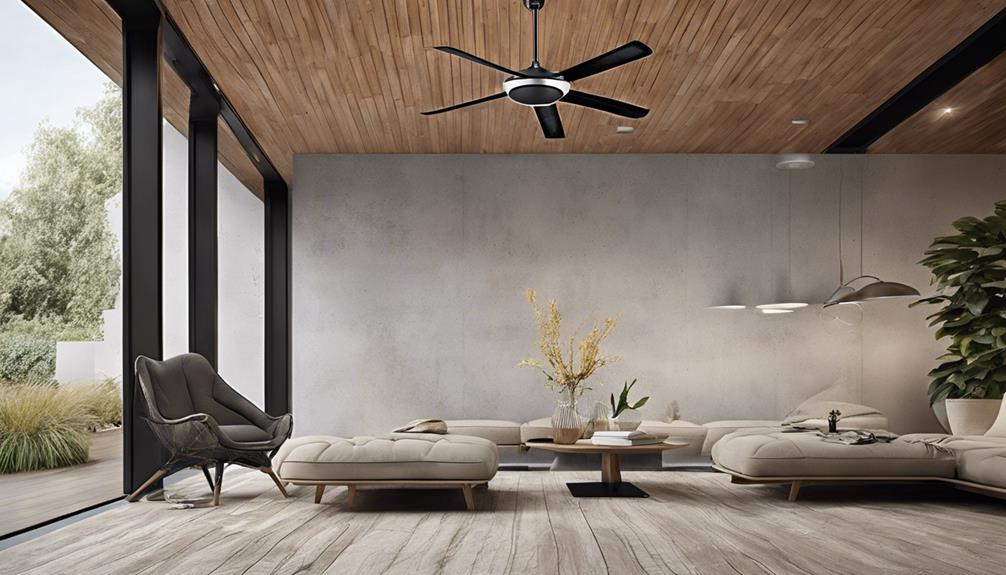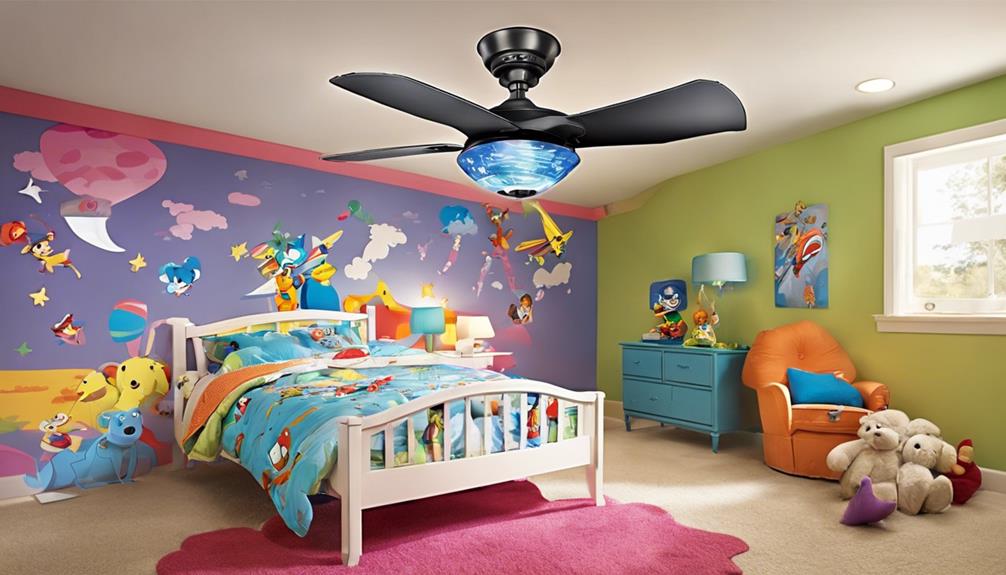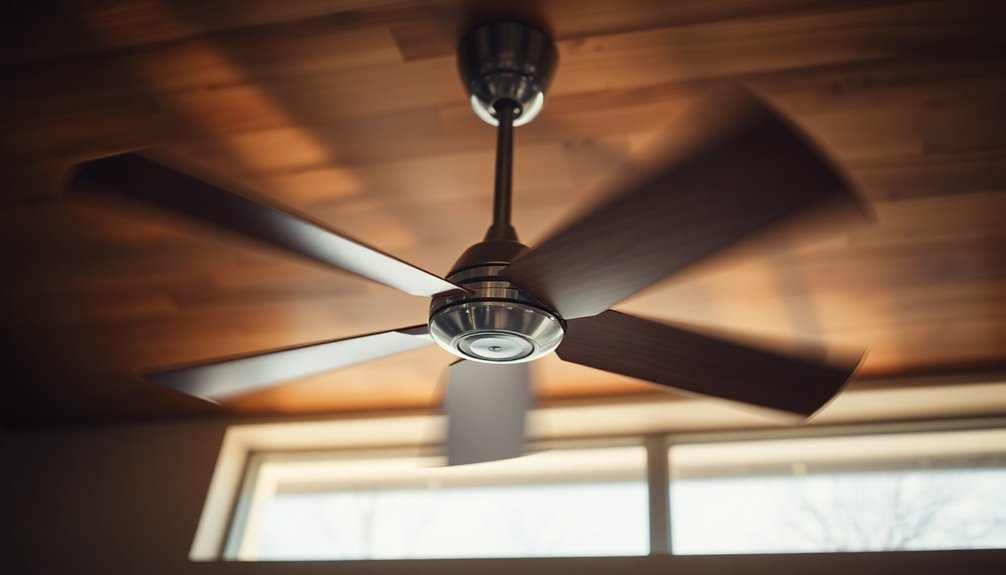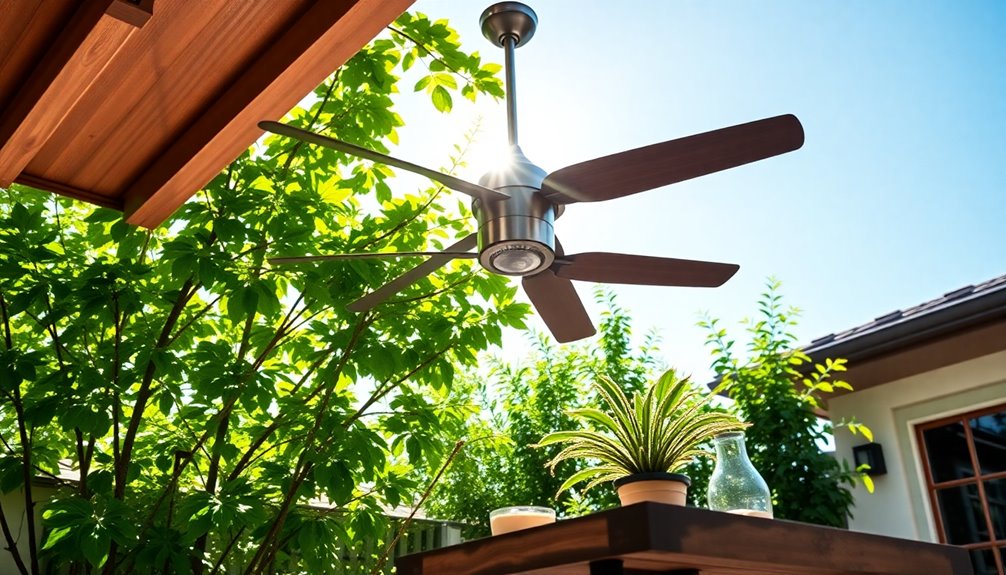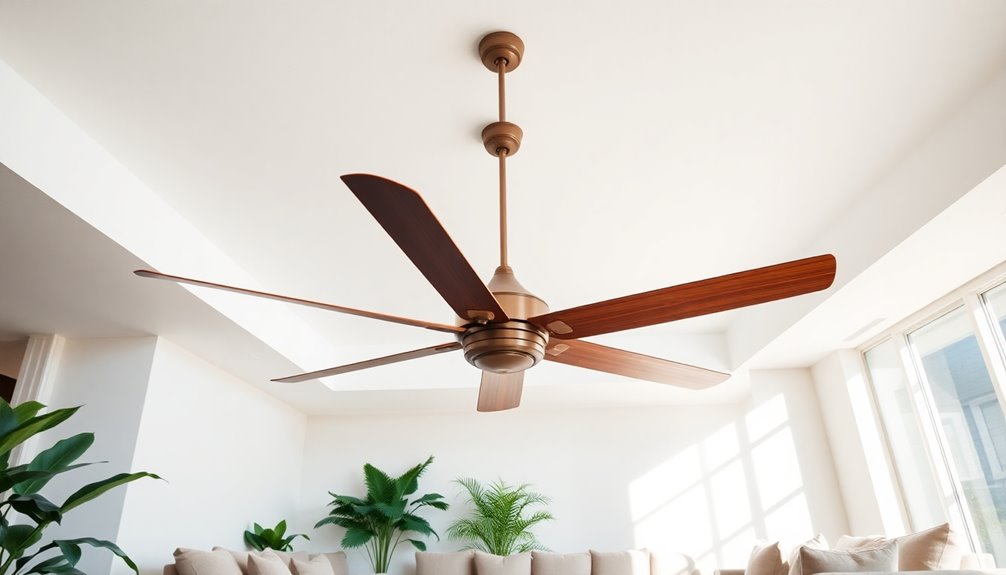When comparing indoor and outdoor ceiling fans, key differences arise in materials, construction, size, airflow, performance, efficiency, location suitability, weather resistance, cost, maintenance requirements, and aesthetics. Outdoor fans are built with durable materials like ABS plastic and galvanized steel, featuring sealed wiring to resist moisture, while indoor fans typically use wood, particle board, or plastic. Outdoor fans are larger for superior airflow, withstand weather elements, and are engineered for quiet efficiency. They are suitable for areas with rain, wind, and snow exposure, whereas indoor fans prioritize design and decoration.
Understanding these variations is crucial for selecting the right fan for your space and ensuring optimal performance.
Key Takeaways
- Outdoor fans are larger and crafted with weather-resistant materials for durability and superior airflow.
- Indoor fans prioritize higher velocity air movement for enclosed spaces, while outdoor fans withstand weather elements.
- Wet-rated outdoor fans are engineered for all weather conditions, while damp-rated fans are versatile for indoor and outdoor use.
- Outdoor fans require more maintenance due to exposure, with regular cleaning and rust prevention techniques crucial.
- Outdoor fans are a worthy investment with costs ranging from $2,000 to $6,000, offering efficient and durable cooling solutions.
Materials Used
When selecting a ceiling fan, it's important to consider the materials used, as outdoor and indoor fans differ significantly in this aspect. Outdoor fans are crafted with materials like ABS plastic and galvanized steel to combat outdoor elements effectively. These materials are chosen for their durability and ability to resist rust, corrosion, and warping, making outdoor fans more resilient to the challenges of outdoor environments.
In contrast, indoor fans commonly use materials such as wood, particle board, vinyl, or plastic, which aren't designed to withstand outdoor conditions.
The materials in outdoor fans are specifically chosen to endure moisture and extreme temperatures. Outdoor fans feature airtight enclosures and anodized finishes that provide protection against moisture, ensuring longevity and performance in various outdoor settings. By selecting the right materials for your ceiling fan based on whether it will be placed indoors or outdoors, you can ensure optimal performance and durability for your specific needs.
Design and Construction Variances

In crafting both indoor and outdoor ceiling fans, manufacturers employ distinct design and construction variances to ensure optimal performance in their respective environments. Outdoor ceiling fans are specially constructed using materials like ABS plastic and galvanized steel to withstand moisture and weather elements. These fans are designed to handle direct water exposure, necessitating features like sealed wiring to prevent electrical shorting from moisture.
On the other hand, indoor fans lack the protective casing and sealing required for outdoor conditions, making them unsuitable for areas with high humidity or direct exposure to water. The differences in construction and design between outdoor and indoor fans result in outdoor ceiling fans being more durable and weather-resistant.
Therefore, when choosing between the two, it's crucial to consider factors like wet rating, damp rating, and overall weather resistance to ensure the longevity and performance of the fan in its intended environment.
Size and Airflow Capacity
Outdoor ceiling fans are generally larger than indoor fans, moving significantly more air for superior airflow in spacious areas. The blade span size of outdoor fans varies from small areas to wide open spaces, ensuring optimal cooling efficiency.
Considerations such as fan size, airflow levels, and room coverage are key factors when choosing between indoor and outdoor ceiling fans.
Fan Size Importance
Understanding the importance of fan size in relation to airflow capacity is crucial for optimizing the cooling efficiency of an outdoor ceiling fan. The blade span of the fan directly impacts its airflow capacity, making it essential to select the right size for the designated outdoor area.
Guidelines suggest a range of blade spans from 18 to 36 inches for small spaces, while areas with more significant square footage may require fans with blade spans of 65 inches or larger. By choosing the correct fan size, you ensure that the airflow coverage is adequate, ultimately enhancing the cooling effectiveness in the outdoor space.
Achieving optimal cooling efficiency is contingent upon matching the fan size to the specific area, providing comfort and relief during warmer days.
Airflow Efficiency Levels
Enhancing airflow efficiency levels in ceiling fans involves optimizing both size and airflow capacity to suit specific indoor or outdoor environments. When comparing outdoor fans to indoor fans, several key factors impact their airflow efficiency:
- Outdoor fans are larger in size, moving significantly more air for open outdoor spaces.
- Motor power and blade pitch in outdoor fans contribute to their superior airflow capacity.
- Outdoor fans utilize airfoil blades for quiet and effective airflow.
- Higher CFM ratings in outdoor fans indicate their enhanced airflow efficiency over indoor fans.
Room Coverage Consideration
Proper sizing of ceiling fans is essential for ensuring effective airflow and optimal cooling in various outdoor spaces. The blade span plays a crucial role in determining the fan's ability to circulate air efficiently.
For very small outdoor areas, a blade span ranging from 18-36 inches is recommended. However, in wide-open outdoor spaces, it's advisable to choose ceiling fans with blade spans of 65 inches or more to achieve optimal cooling effectiveness.
Selecting the right size outdoor ceiling fan is key to enhancing air circulation and maintaining comfort in the designated area. By adhering to guidelines for proper sizing, you can maximize the cooling benefits of your outdoor fan and create a pleasant environment for relaxation and enjoyment.
Performance and Efficiency

In comparing indoor and outdoor ceiling fans, the efficiency and performance dynamics play a crucial role in determining their suitability for different environments. When evaluating these factors, there are key distinctions between indoor and outdoor fans to consider:
- Indoor fans prioritize higher velocity air movement for effective cooling in enclosed spaces.
- Outdoor fans, on the other hand, are designed to withstand various weather elements while providing optimal cooling in open areas.
- Motor power and blade pitch significantly impact the performance of indoor fans, tailored for indoor settings.
- Outdoor fans, with airfoil blades and a higher CFM rating, are engineered for quiet and efficient airflow, moving significantly more air than indoor counterparts.
Understanding these distinctions can help you choose the right ceiling fan for your specific needs, ensuring optimal performance and efficiency in either indoor or outdoor settings.
Location Suitability

Indoor ceiling fans are specifically designed for dry, indoor areas, while outdoor ceiling fans are engineered to withstand exposure to elements like rain, wind, and snow. Placing an indoor fan in an outdoor setting where it is exposed to moisture can lead to damage and safety hazards. It's crucial to select the right fan based on location suitability to ensure optimal performance and safety. Here is a comparison between indoor and outdoor ceiling fans:
| Category | Indoor Fans | Outdoor Fans |
|---|---|---|
| Moisture Exposure | Not Suitable for Moisture | Built to Withstand Moisture |
| Safety Hazards | Lower risk outdoors | Higher risk indoors |
| Rating Types | Damp Rated | Wet Rated |
| Durability | Less durable outdoors | Highly durable |
Choosing the appropriate fan for your space not only enhances the overall aesthetic but also ensures longevity and safety. Outdoor ceiling fans are specifically crafted to endure outdoor conditions, making them the ideal choice for areas with moisture exposure.
Rating Types

Crafted specifically for outdoor environments, Wet-Rated fans are engineered to withstand all weather elements, ensuring durability and performance.
- Wet-rated ceiling fans are ideal for patios, gazebos, and other outdoor spaces exposed to rain and snow.
- Indoor ceiling fans are designed for dry, indoor areas where moisture isn't present.
- Damp-rated ceiling fans offer versatility, suitable for both indoor and outdoor locations with moisture and humidity.
- Understanding the differences between these rating types is crucial for selecting the right fan for your indoor and outdoor areas.
Durability and Weather Resistance

When considering ceiling fans for outdoor use, it becomes evident that durability and weather resistance are paramount factors in ensuring long-lasting performance. Outdoor ceiling fans are specifically designed to withstand various weather conditions, making them ideal for spaces like patios, decks, and gazebos. These fans are typically made from robust materials such as ABS plastic and galvanized steel, ensuring they can endure wind, rain, and direct water exposure. There are two main ratings for outdoor fans: wet-rated and damp-rated. Wet-rated fans are built to handle intense weather like heavy rain and salty ocean spray, while damp-rated fans can withstand high humidity levels and occasional moisture in covered outdoor areas.
| Feature | Wet-Rated Fans | Damp-Rated Fans |
|---|---|---|
| Weather Resistance | Designed for intense weather conditions | Can handle high humidity and occasional moisture |
| Suitable For | Areas with heavy rain or salty ocean spray | Covered outdoor spaces with occasional dampness |
| Ideal Locations | Exposed outdoor areas like patios and decks | Covered patios, porches, and gazebos |
Cost Differences

The price disparity between indoor and outdoor ceiling fans is primarily influenced by factors such as durability, weather resistance, and overall performance. When considering cost differences, outdoor ceiling fans tend to be pricier due to their enhanced features tailored for outdoor elements. Here are some key points to consider regarding the cost disparity between indoor and outdoor fans:
- Outdoor fans typically range from $2,000 to $6,000, reflecting their durability and efficiency.
- Operating an outdoor fan may cost around $1 per day in terms of energy consumption, but the potential savings in the long run can offset the initial expense.
The higher price tag of outdoor fans is justified by their ability to withstand outdoor elements, ensuring longevity and performance. While the upfront cost of outdoor fans may be higher, the efficiency and durability they offer make them a worthy investment, potentially saving on energy costs over time.
Maintenance Requirements

Outdoor ceiling fans require regular maintenance to ensure optimal performance. Cleaning frequency is crucial to remove dirt and debris that can affect the fan's efficiency.
Rust prevention techniques and weatherproofing needs are also essential aspects of outdoor fan maintenance.
Cleaning Frequency
Maintaining ceiling fans, whether indoor or outdoor, involves adhering to specific cleaning frequencies to ensure optimal performance and longevity. When it comes to cleaning frequency:
- Outdoor ceiling fans should be cleaned at least once a month due to exposure to outdoor elements.
- Regular cleaning helps prevent clogging, motor strain, and airflow issues.
- Indoor ceiling fans typically require cleaning every 2-3 months to operate consistently.
- Following manufacturers' guidelines for cleaning and maintenance can extend the lifespan of both indoor and outdoor fans.
Weatherproofing Needs
To ensure the longevity and optimal performance of ceiling fans, it's crucial to address specific weatherproofing needs, especially for outdoor fans exposed to elements like rain and wind.
Outdoor ceiling fans require more maintenance than indoor fans due to their exposure to outdoor elements. Regular weatherproofing measures, such as using rust-resistant materials and sealing electrical components, are essential to prevent rust, corrosion, and water damage.
Rust Prevention Techniques
One effective method for preventing rust on ceiling fans involves regularly cleaning and lubricating the blades to inhibit buildup. When aiming to maintain outdoor ceiling fans and prevent rust formation, consider these techniques:
- Utilize rust-resistant materials like stainless steel or galvanized finishes for enhanced durability.
- Address any signs of rust or corrosion promptly to prevent further damage.
- Ensure proper airflow around the fan to reduce moisture buildup and rust formation.
- Implement a routine maintenance schedule to inspect and maintain outdoor fans for long-term rust prevention.
Aesthetics and Style Options

Outdoor ceiling fans offer a diverse range of styles and designs tailored specifically for outdoor spaces. While indoor fans often boast more decorative options and intricate details, outdoor fans prioritize functionality and durability to withstand outdoor elements.
Indoor fans may feature wood finishes and ornate blades, enhancing the indoor aesthetic with a stylish flair. In contrast, outdoor fans tend to have a more streamlined and simple design to ensure longevity in various weather conditions.
The difference in design options between indoor and outdoor fans reflects the specific needs of each setting. Indoor fans focus on aesthetics and decorative features, while outdoor fans emphasize durability and resistance to outdoor elements.
When choosing between indoor and outdoor ceiling fans, consider the balance between style and functionality to complement your space effectively.
Frequently Asked Questions
What Is the Difference Between an Indoor and Outdoor Ceiling Fan?
The difference between an indoor and outdoor ceiling fan lies in their design and construction. Outdoor fans are built to withstand weather elements, with special ratings for damp or wet conditions. They use durable materials and have stronger motors.
Indoor fans lack these features and can get damaged outdoors. When choosing between them, consider energy efficiency, size options, blade material, style choices, and most importantly, where you plan to install them for optimal performance and safety.
Can an Indoor Ceiling Fan Be Used Outdoors?
Yes, an indoor ceiling fan shouldn't be used outdoors due to safety concerns. Doing so can lead to electrical issues, corrosion, and fire hazards.
Opt for an outdoor ceiling fan designed to withstand outdoor elements like moisture and wind. These fans offer better weather resistance, making them safer and more reliable for outdoor use.
Remember to always prioritize safety and choose the appropriate fan for each environment.
What Makes a Fan an Outdoor Fan?
When considering what makes a fan suitable for outdoor use, factors like weather resistance, damp rating, UV protection, rust-proof construction, waterproof motor, outdoor installation, and moisture control are crucial. These features ensure the fan can withstand outdoor conditions, preventing damage and maintaining optimal performance.
Choosing an outdoor fan over an indoor one in outdoor spaces reduces risks like electrical errors and fires, enhancing safety and longevity.
How Do You Tell if a Ceiling Fan Can Be Used Outdoors?
To determine if a ceiling fan can be used outdoors, consider its weather resistance, damp location suitability, rust-proof materials, wet rating, UV protection, ability to withstand outdoor elements, and moisture control features.
Look for fans with these qualities to ensure safe outdoor use. Make sure the fan is designed for direct exposure to water and has sealed wiring and a protected motor.
Location and exposure level to elements should guide your choice.
How do the Benefits of Ceiling Fans in Bathrooms Compare to Indoor and Outdoor Ceiling Fans?
Ceiling fans for bathrooms offer unique benefits compared to indoor and outdoor ceiling fans. They help to control humidity, prevent mold and mildew growth, and improve air circulation in a small, enclosed space. Additionally, they provide a refreshing breeze and help to distribute heat evenly in the room.
Conclusion
As we've explored the key differences between indoor and outdoor ceiling fans, it's clear that each type has its own set of advantages and considerations.
But before you make a decision on which fan to choose, remember that there's one more crucial factor to consider that could impact your choice.
Stay tuned for our next article where we reveal the ultimate secret to selecting the perfect ceiling fan for your space.
